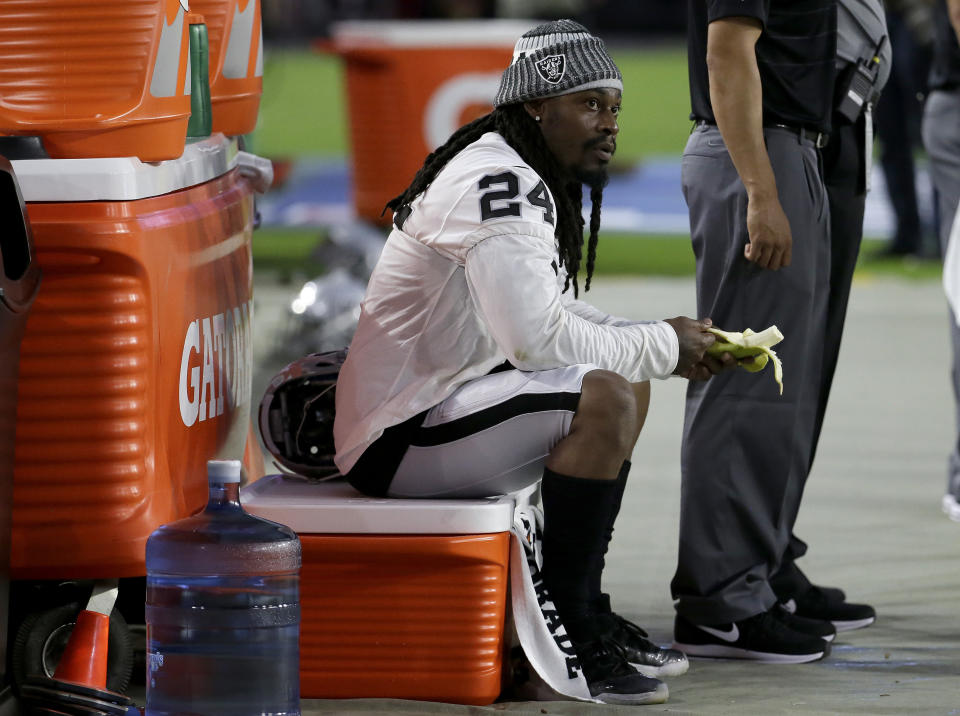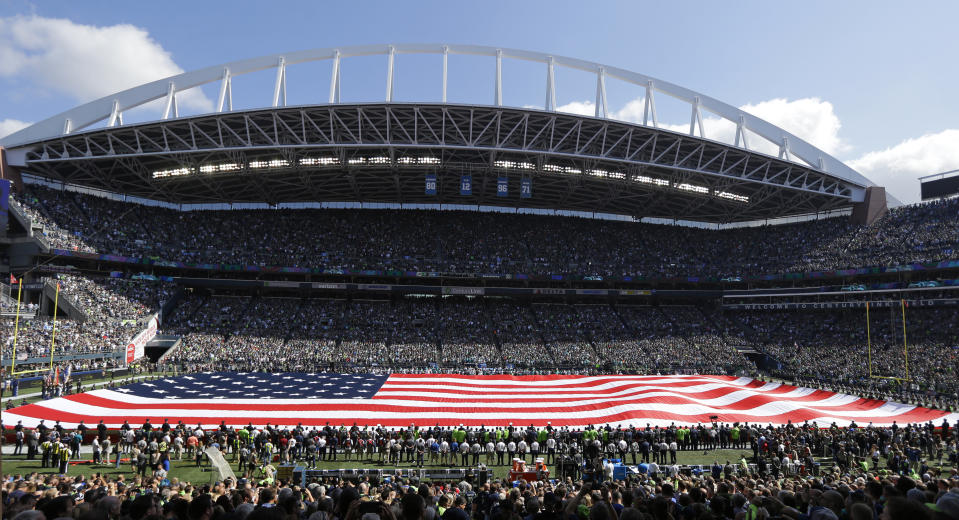Never mind Colin Kaepernick, why is the national anthem played at sporting events in the first place?
One week into the preseason and the hottest topic in the NFL is who is or isn’t standing for the national anthem, not to mention the continued unemployment of Colin Kaepernick, in part because he started this protest a year ago.
Kaepernick was trying to shine light on what he perceived as police violence against minorities and sparked a movement that carries on – Seattle’s Michael Bennett said he didn’t stand Sunday partially because of the ugly situation in Charlottesville, Virginia, while Oakland’s Marshawn Lynch sat on Saturday but hasn’t given a reason. He may never.
Either way, it’s all about the anthem, the anthem, the anthem.
Which begs a different question that has nothing to do with constitutional rights of some players to stand or not to stand, let alone the capitalistic right of some fans to stop supporting them, or supporting them even more, because of it.
Why play the anthem before football games, or any games, at all?
Ostensibly, it is patriotic. For many people, though, it isn’t, and not just the ones protesting. Scan the crowd during the anthem at any sporting event and you’ll see people talking to each other, looking at their phones, eating, drinking or scooting off to the bathroom.
How many of them are standing only out of societal pressure? In some stadiums they sing along. In others, recording artists get to use the moment in an effort to market and promote themselves. In others, the crowd playfully highlights certain words – “ohh” they shout at “O say does that Star-Spangled Banner,” or they yell “red” if that corresponds with team colors.
No one plays more than the first verse (there are four in the original song), probably because the public can’t even hold it together for one.
This is hardly the solemn tribute to the military some claim.

Way back in 1954, the Washington Post reported, the Baltimore Orioles temporarily stopped playing the song because general manager Arthur Ellers found crowd behavior during the anthem to be “very distasteful.” To the World War I vet, the anthem at a sporting event didn’t make sense.
It still doesn’t, although just noting that will rile up plenty of people … many of whom have no doubt chomped popcorn through a rendition.
So why is it that a stadium full of tens of thousands of rowdy people, many of whom have been drinking all day, has been deemed the appropriate time for a mass act of unity? And why, when a good number of people in the crowd are sitting/talking/eating etc. during the anthem, is the conduct of every player and coach considered so important?
They don’t play the anthem before big concerts. Or plays. Or movies. Or the opening credits of a television show. Or before work (in most cases). Or during the morning commute. Or so on and so on.
Dare the most pro-American television or radio host to play the full song during their show and they’ll balk, knowing bored viewers and listeners would just flip the switch.
So why sporting events at all? And why the massive displays that have become the norm post-Sept. 11 – with 100-yard flags and a doubling down of patriotic singing during the seventh-inning stretch. Prior to 2001 (and even sometimes after it), it wasn’t uncommon for teams to remain in the locker room until after the anthem. Now they are expected to stand at attention, or even help hold the flags, in a moment that is now a political referendum.
The start of this tradition is more than a bit dubious. The 1918 World Series between the Boston Red Sox and Chicago Cubs is credited as the genesis of “The Star-Spangled Banner” and sports. With Boston’s Babe Ruth in the process of pitching a Game 1 shutout, the Cubs crowd was listless, until, according to The New York Times account from that day, a military band played “The Star-Spangled Banner” during the seventh-inning stretch. The fans suddenly sprung to life.

“Onlookers exploded into thunderous applause and rent the air with a cheer that marked the highest point of the day’s enthusiasm,” the Times reported at the time.
Perhaps seeing this as much of a way to generate in-stadium excitement as anything to do with supporting the country, Cubs officials had it played again in Games 2 and 3. Then Boston, not to be outdone, played it before Game 4 and so on.
Soon the song was played during the World Series and on national holidays. Eventually it became an everyday thing and carried over into other sports.
The military acknowledges it sees all of this as a recruiting tool. Yet even that gets murky. In 2015, Arizona Senators John McCain and Jeff Flake revealed that the Department of Defense shelled out $6.8 million to get college and pro teams to stage patriotic events during games. That supposedly feel-good moment for America was actually “paid patriotism.”
“Many of the ceremonies honoring troops at professional sporting events are not actually being conducted out of a sense of patriotism, but for profit,” McCain said at the time.
The NFL, among others, eventually returned some $700,000 to the Department of Defense.
Maybe serving as a roll call of patriotism isn’t the business of the NFL. It certainly doesn’t seem to be helping right now. Or maybe this is just America – a big, broiling argument that sometimes doesn’t make a lot of sense or work the way it’s intended. It’s the beauty of this place.
Which might be how we got to the start of another football season where the playing of the pregame anthem, a unique and unlikely tradition, has once again come to dominate the headlines.
More from Yahoo Sports:
• Jeff Passan: Why Miami needs to trade its biggest star now
• Toxicology report on Tiger Woods released
• How one man’s $2.5 million golf bet went horribly wrong

 Yahoo News
Yahoo News 
